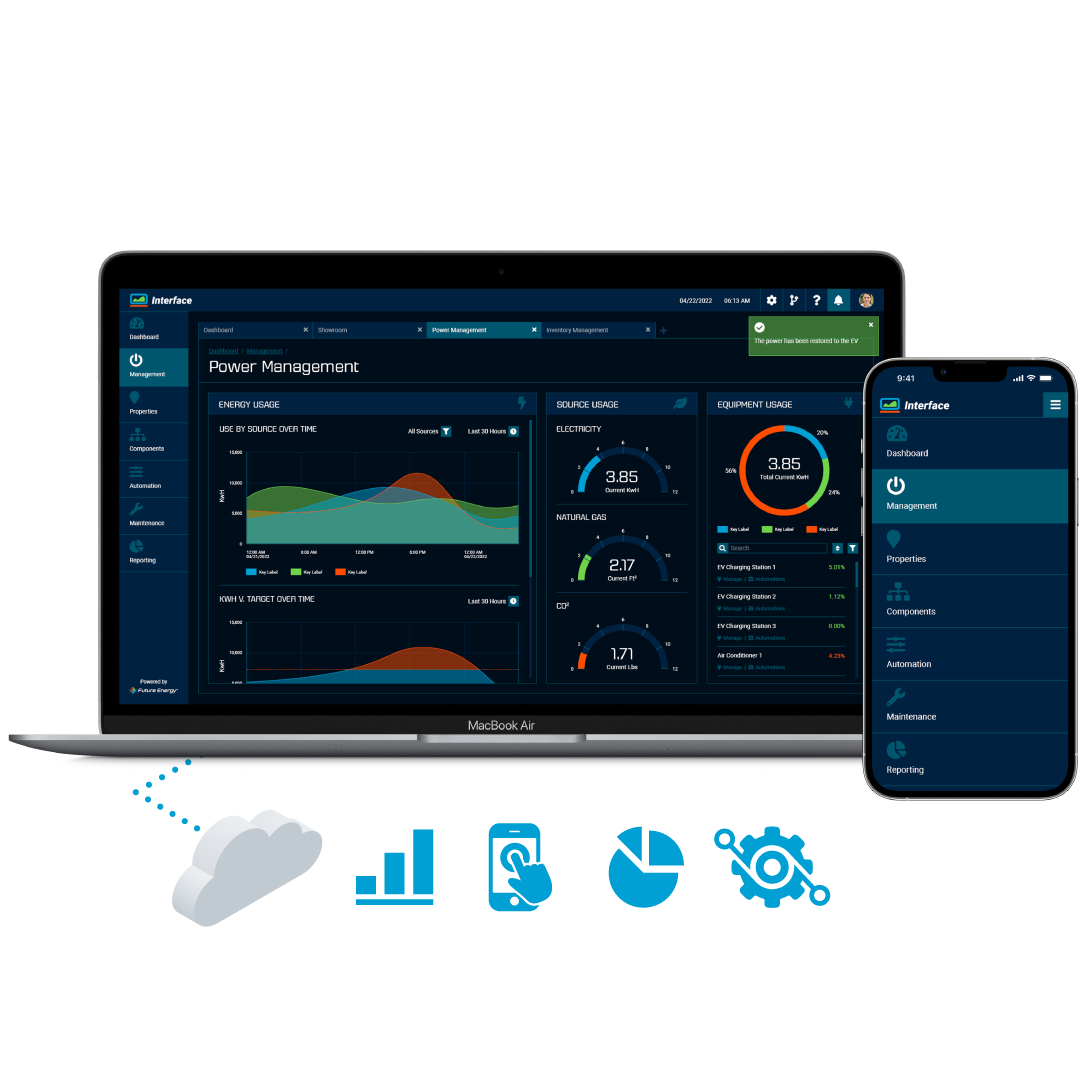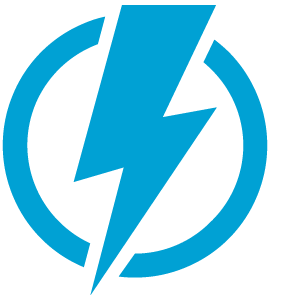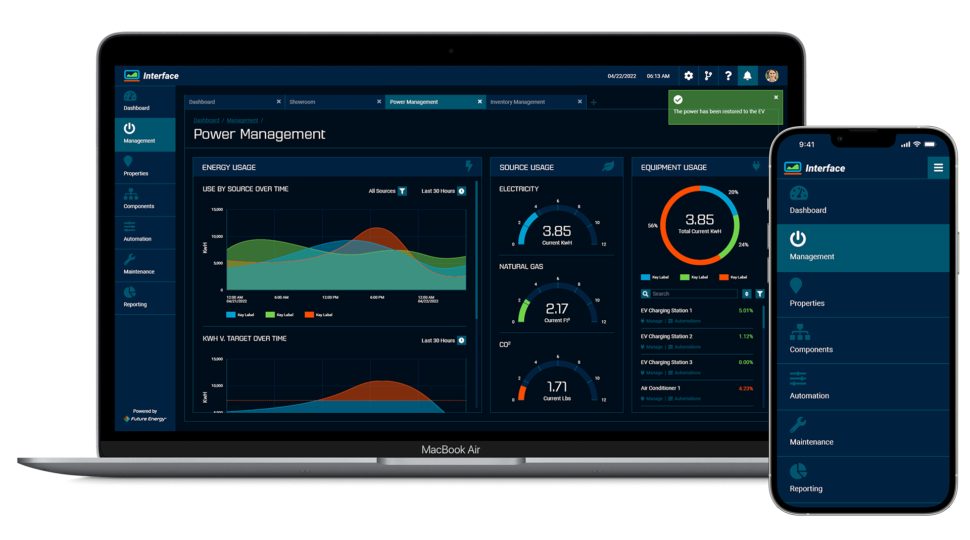Interface 101

Without a thermostat, an air conditioner would run at random, resulting in uncontrollable energy costs. Similarly, EV chargers require a monitoring method that helps manage and measure electricity use. How exactly does the monitor work though, and how can this software help your company achieve its business objectives?
Welcome to Interface 101.
Get Started
Why Is Charging Management Software Critical for EV Solutions?
About seven years ago, Future Energy was regularly installing electric vehicle (EV) charging stations for our clients in the healthcare industry. Many companies weren’t sure how many employees or visitors would be using EV chargers and they wanted to ensure that the chargers wouldn’t exceed the electrical capacity of the property. Future Energy realized that our clients across many diverse industries needed a solution to help address and manage energy use cases particular to their industries. We developed Interface, a software-as-a-service that monitors and controls all of a company’s electrical systems in real time from any device.
Mitigating Unexpected Costs from Peak Load
To determine the economic value that an EV charging management platform could provide, Future Energy ran an electrical load profile of a hypothetical business. As a baseline, we used the actual historical energy usage of a New York auto dealership prior to its installation of EV chargers.
The hypothetical dealership charged its inventory using a level 3 charger, also known as a direct-current fast charger. The total annual load increased by about 50,000 kilowatt hours, which was about a 15% increase in metered usage. A business looking at this example might expect to pay a corresponding 15% more in electricity expenses for the year, which would translate to an additional $478.
However, EV charger usage also resulted in a much greater increase to the business’s peak demand. Peak demand is the maximum amount of power that all the building’s equipment draws from the grid at one time during the billing period. In this case, peak demand increased by 200 kilowatts, which was a 228% increase over the company’s peak demand before EV charger installation. As a result, the hypothetical company in this example saw its annual electricity expenses go up by an additional $30,000, which was much more than the company might have expected.
Charging management software puts a ceiling on peak demand. It mitigates wild increases in electricity costs.
Mitigating Unexpected Costs from Peak Load
To determine the economic value that an EV charging management platform could provide, Future Energy ran an electrical load profile of a hypothetical business. As a baseline, we used the actual historical energy usage of a New York auto dealership prior to its installation of EV chargers.
The hypothetical dealership charged its inventory using a level 3 charger, also known as a direct-current fast charger. The total annual load increased by about 50,000 kilowatt hours, which was about a 15% increase in metered usage. A business looking at this example might expect to pay a corresponding 15% more in electricity expenses for the year, which would translate to an additional $478.
However, the EV charger usage also resulted in a much greater increase to the business’s peak demand. Peak demand is the maximum amount of power that all the building’s equipment draws from the grid at one time during the billing period. In this case, peak demand increased by 200 kilowatts, which was a 228% increase over the company’s peak demand before EV charger installation. As a result, the hypothetical company in this example saw its annual electricity expenses go up by an additional $30,000, which was much more than the company might have expected.
Charging management software puts a ceiling on peak demand. It mitigates wild increases in electricity costs.


Driving Cost Savings Using Electric Software
Utility companies offer time-of-use rates that reward businesses that reduce their energy consumption when there is high demand on the grid. In many cases, your business could cut your cost per kilowatt in half for electricity use during off-peak hours—say between 11:00 p.m. and 7:00 a.m. An EV charging system that schedules EV charging for off-peak hours shifts the energy load to the time of day when demand on the grid is lowest.
Generating Operational Insight Through Data-Driven Charging Management System
Charging management software collects and compares energy use and operational data across your company’s devices and systems. Your business can use this information to easily generate reports and analyses that then help you make proactive decisions to save on operational costs.
Future Energy’s Interface Software
Interface is a data visualization and energy management software-as-a-service solution created by Future Energy. Interface communicates with a cloud system to compile live and historical data from all EV chargers, IoT devices, and other systems in one comprehensible view. In this way, Interface helps to provide insight into your energy use. This data includes:
- Utility power demand
- Cost of EV charging
- EV charging session times
- Number of EVs charged
- Charging efficiency, such as average station idle time
- Average and maximum power utilization
- Power use of EV chargers compared to that of other building systems

How Does Interface Work with My Other Business Systems?
From its inception, Interface has been designed to be hardware agnostic. Beyond EV chargers, Interface manages energy devices such as smart meters, panels, and breakers. It also hooks up to lighting, thermostats, video, and other IoT devices.
Your business can see, evaluate, and compare energy use across your entire portfolio from one dashboard. This includes all sites, their devices, and their data. Interface also provides site-level management, which allows you to view devices across just one property and automate or configure device groups within a single site.
Using Interface for Power Management
Future Energy includes consulting and client success services with every paid Interface software subscription. We assign a dedicated Future Energy assistant to your account.
Obtaining An Energy Baseline
Before we make recommendations on how efficient energy management can fulfill your business objectives, we evaluate your business’s current energy. Future Energy then connects your site’s devices to Interface so that we fully understand the margin of load your business can add without exceeding peak capacity.
Developing A Plan for Energy Use
With a full picture of your business’s energy use, Future Energy presents options for various strategies on how to manage and measure energy. We work with your company to determine a plan for the integration of EV chargers.
As your consultant, Future Energy knows your energy tariff and when you are in danger of exceeding your load capacity. Through Interface, we set up automations that react in real-time to prevent you from exceeding a preset amount.
Installing Interface
Future Energy provides a hardware box called Interface Edge that connects all your IoT devices to Interface Cloud. Through the cloud, Interface monitors your site remotely and sends commands to all devices as required. On a site-by-site basis, Future Energy builds automations and custom controls that use data to help optimize Interface specifically for your business.
In addition to these custom automations and controls, Future Energy is continuously developing and improving the software in general. Through Interface Cloud, your system receives automatic updates, upgrades, and new features to Interface as they become available.
Adopting A Complete Solution
Interface is the back end of a turnkey solution Future Energy provides for businesses who wish to install EV chargers. Future Energy also builds out electrical infrastructure as required, orders hardware, supervises the installation, processes utility applications, and provides guidance on financial incentives.
Future Energy’s consulting services don’t stop upon installation of Interface. Rather, we offer additional maintenance and site inspection services, seamlessly integrating tickets within Interface.
Get More Information About Interface
Contact Future Energy to find out how your company can get started using Interface today.
Let’s Connect
Designing smart building connectivity begins with a personal connection. We’ll discuss your goals, budget and timeline, and take it from there.
